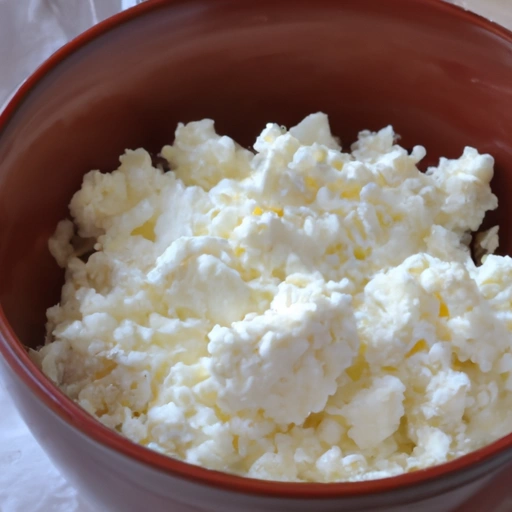Cottage Cheese
Description

Cottage cheese is a fresh cheese curd product with a mild flavor. It is drained, but not pressed, so some whey remains and the individual curds remain loose. By comparison to other cheeses, it is not aged. It is made from cow's milk by adding an acid to milk, such as lime juice or vinegar, and then draining the liquid portion from the curd. This cheese's popularity comes from its versatility and nutritional benefits, as well as its characteristic lumpy texture, which can range from small to large curds.
Common uses
Cottage cheese can be enjoyed on its own or used as an ingredient in both savory and sweet dishes. It's commonly used as a topping for salads, in sandwiches, and as a filler in pastas such as lasagna. It's also a popular choice for a protein-rich snack, often paired with fruits like pineapple, peaches, or berries.
Nutritional value
Calories
Approximately 98 calories per 100 grams (3.5 oz).
Protein
About 11 grams (0.39 oz) of protein per 100 grams (3.5 oz).
Fat
Contains about 4 grams (0.14 oz) of fat per 100 grams (3.5 oz), though low-fat and non-fat varieties are also available.
Carbohydrates
Roughly 3 grams (0.11 oz) of carbohydrates per 100 grams (3.5 oz).
Vitamins
Rich in B-complex vitamins, especially B12, and a good source of vitamin A.
Minerals
Contains calcium, phosphorus, selenium, and magnesium.
Health benefits
Cottage cheese is known for its high protein content, which is beneficial for muscle repair and growth. It's also rich in calcium for strong bones and contains probiotics that can aid digestion. With its low carbohydrate content, it is a good choice for those on a low-carb diet.
Potential risks
As with any dairy product, those with lactose intolerance or a dairy allergy should avoid cottage cheese. Some brands also have high sodium content, which can be a concern for individuals watching their salt intake.
Common recipes
Used in a variety of recipes such as salads, dips, pancakes, lasagna, and even desserts like cheesecake.
Cooking methods
Can be eaten raw or cooked. When heated, it softens but does not melt, making it a unique cheese to cook with.
Pairing with other ingredients
Works well with fresh fruits, herbs, honey, nuts, and used as a substitute for ricotta or cream cheese in various recipes.
Summary
Cottage cheese is a versatile, mild-flavored fresh cheese that is rich in protein and nutrients, with a unique texture that makes it a favorite in many dishes. With its historical roots as a simple peasant food, it has evolved into a health-food staple around the world. Whether used in cooking or enjoyed on its own, cottage cheese is a nutritious addition to a balanced diet.